Quadrature Sampling Detector Introduction
(go directly to build notes)Quadrature Sampling Detector Schematic
(Resistor testpoints (hairpin, top, or left-hand lead), as physically installed on the board, are marked in the schematic with red dots)
(Click for Full Schematic)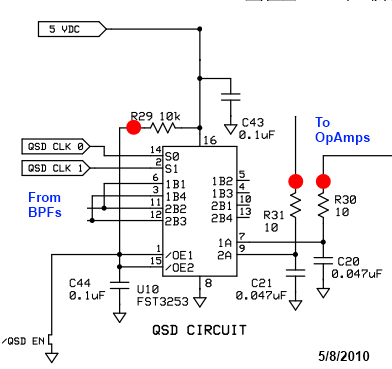
(above schematic has clickable areas that can be used for navigation)
(go directly to build notes)Quadrature Sampling Detector Bill of Materials
Stage Bill of Materials
(resistor images and color codes courtesy of WIlfried, DL5SWB's R-Color Code program)
| Check | Count | Component | Marking | Category |
|---|---|---|---|---|
| ❏ | 1 | 10 ohm 1/4W 1% | br-blk-blk-gld-br
 | 1/4W |
| ❏ | 1 | 10 ohm 1/4W 1% | br-blk-blk-gld-br
 | 1/4W |
| ❏ | 1 | 10 k 1/6W 5% | brn-blk-ora-gld
 | 1/6W |
| ❏ | 2 | 0.047 uF 5% | 473
 | Ceramic |
| ❏ | 2 | 0.1 uF | (smt) black stripe
 | SMT 1206 |
| ❏ | 1 | FST3253 mux/demux switch | FST3253
 | SOIC-16 |
Quadrature Sampling Detector Summary Build Notes
- Install Bottomside Components
- Install Topside Components
- Test the Stage
Quadrature Sampling Detector Detailed Build Notes
Top of the Board
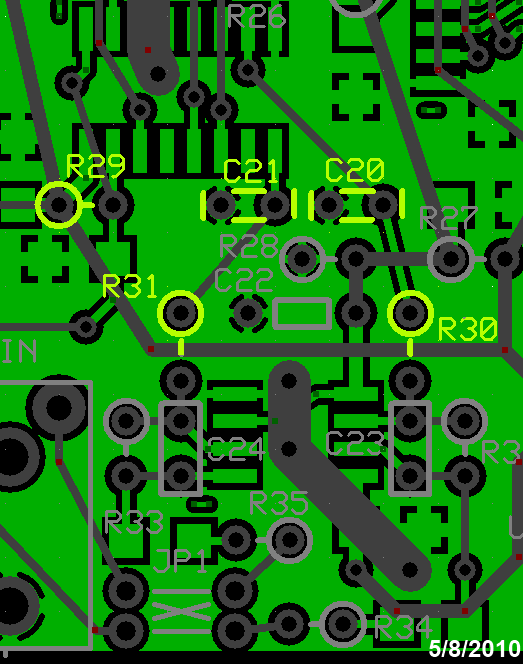
Install Topside Components
| Check | Designation | Component | Marking | Category | Orientation | Notes |
|---|---|---|---|---|---|---|
| ❏ | C20 | 0.047 uF 5% | 473
 | Ceramic | horiz | |
| ❏ | C21 | 0.047 uF 5% | 473
 | Ceramic | horiz | |
| ❏ | R30 | 10 ohm 1/4W 1% | br-blk-blk-gld-br
 | 1/4W | N-S | was R28 |
| ❏ | R31 | 10 ohm 1/4W 1% | br-blk-blk-gld-br
 | 1/4W | N-S | was R29 |
| ❏ | R29 | 10 k 1/6W 5% | brn-blk-ora-gld
 | 1/6W | W-E | was R27 |
Bottom of the Board
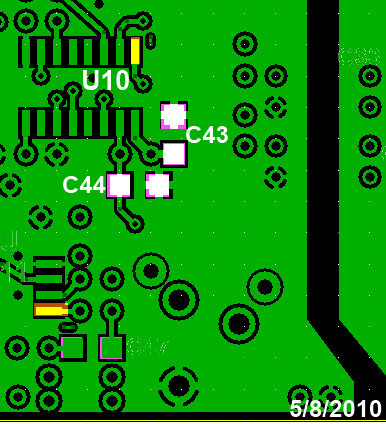
Install Bottomside Components
| Check | Designation | Component | Marking | Category | Orientation | Notes |
|---|---|---|---|---|---|---|
| ❏ | U10 | FST3253 mux/demux switch | FST3253
 | SOIC-16 | Take ESD precautions | |
| ❏ | C43 | 0.1 uF | (smt) black stripe
 | SMT 1206 | white pads | |
| ❏ | C44 | 0.1 uF | (smt) black stripe
 | SMT 1206 | white pads |
Quadrature Sampling Detector Completed Stage
Top of the Board
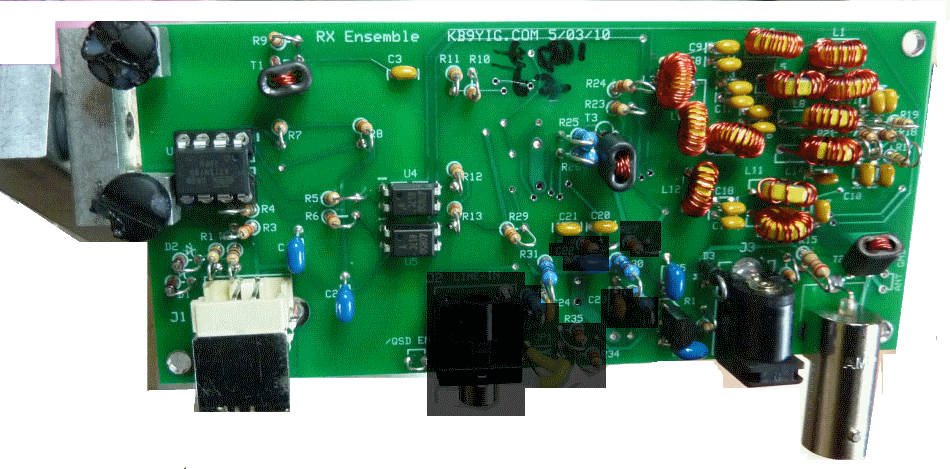
Bottom of the Board
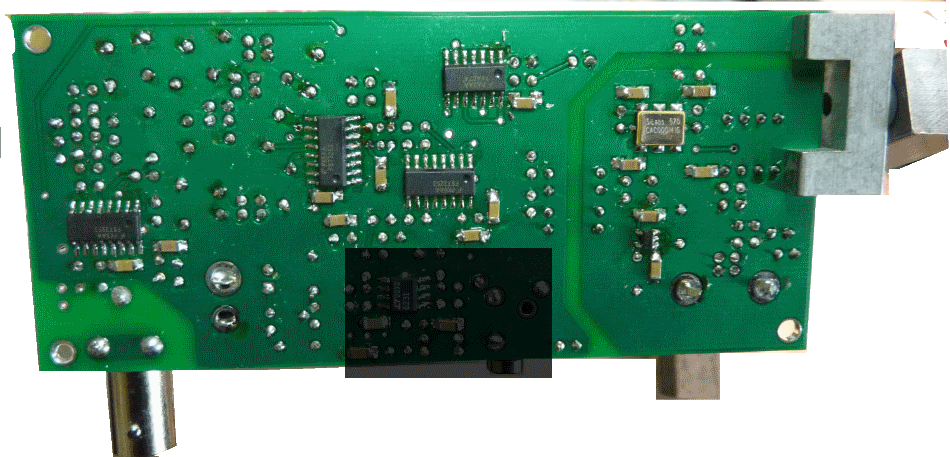
Quadrature Sampling Detector Testing
IC Pin Voltages
Test Setup
It has been observed before that some digital meters are affected by the square wave signals on IC pins and do not always read correctly. The readings you get should approximate 2.5V . The best instrument may be a good oscilloscope. Just be prepared to see slightly different readings on pins 10-13 and 3-6, depending on your DMM (mine is not the best!)
Voltages are measured WRT (regular) ground (/QSD EN shunt )
Power the board, connect USB to PC
Measure pin voltages
It is best to test for these voltages at the actual pins (not the pads), thereby ensuring correct soldering of the pins to the pads.
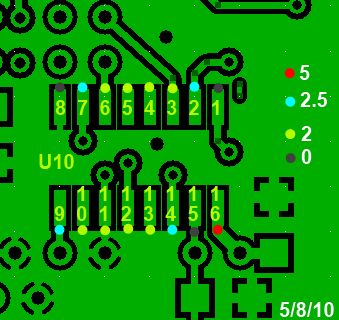
Test Measurements
| Testpoint | Units | Nominal Value | Author's | Yours |
|---|---|---|---|---|
| Pins 1 and 15 (gnd) | V dc | 0 | 0 | _______ |
| Pins 10, 11, 12, and 13 (40% of 5V rail) | V dc | 2.5 | 2.1 | _______ |
| Pins 3, 4, 5, and 6 (40% of 5V rail) | V dc | 2.5 | 2.1 | _______ |
| Pins 7 and 9 (1/2 of 5V rail) | V dc | 2.5 | 2.5 | _______ |
| Pins 2 and 14 (1/2 of 5V rail) | V dc | 2.5 | 2.5 | _______ |
| Pin 8 (gnd) | V dc | 0 | 0 | _______ |
| Pin 16 (5 V rail) | V dc | 5 | 5 | _______ |
(Optional) QSD Output Test
Test Setup
Power up the board and connect the USB cable
Run CFGSR.exe and dial in a desired center frequency
Inject an RF signal at approximately 10 kHz below the dialed in center frequency
Probe the hairpin leads of R30 and R31 with your dual channel scope
Depending upon your scope's sensitivity, you should see two 10 kHz signals in quadrature.
As you vary the injected signal to move it above the center frequency, you should see the quadrature signals change frequency and, at crossover, switch the leading and lagging positions.